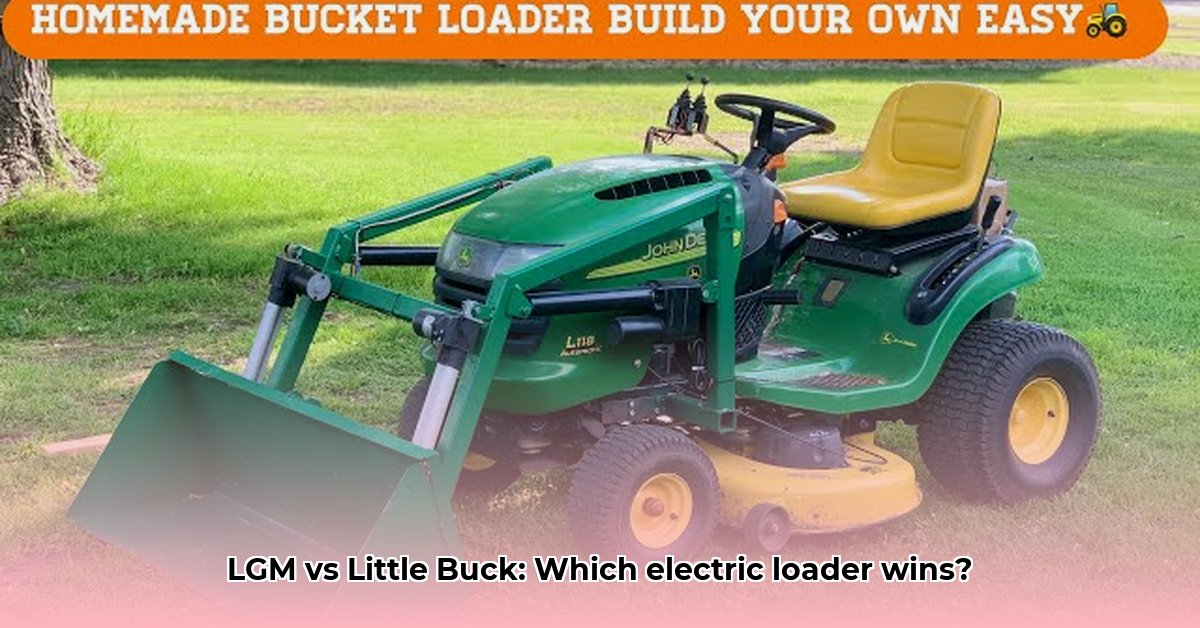
Choosing the right electric front-end loader for your lawn tractor can significantly enhance its capabilities. This review compares two leading contenders: the LGM-100 and the Little Buck Loader, analyzing their features, performance, and suitability for various users. We'll help you decide which loader best meets your needs and budget, whether you're a weekend gardener or a professional landscaper. For more on electric lawn tractors, see this helpful resource.
LGM-100: A Look at the Tech-Focused Loader
The LGM-100 is marketed as a technologically advanced, yet budget-friendly electric front loader. It offers a 350-pound lift capacity, sufficient for most garden tasks. Its electric motor promises quieter operation and potentially lower maintenance than gas-powered alternatives. The joystick control allows for precise lifting and lowering, beneficial for delicate maneuvers. Installation appears relatively straightforward, making it appealing to DIY enthusiasts. However, detailed information on construction materials and long-term durability remains limited. Is this technological edge worth the potential uncertainties?
Pros:
- Potentially competitive price (exact pricing requires further verification).
- User-friendly installation process (based on available information).
- Electric motor for quieter and potentially lower-maintenance operation.
- Precise control via a variable-speed joystick.
Cons:
- Durability and longevity require further independent assessment.
- Limited detailed specifications on construction materials hinder a comprehensive evaluation.
- Compatibility with various lawn tractor models needs further clarification.
Little Buck Loader: Durability and Versatility
The Little Buck Loader emphasizes ruggedness and American-made quality. This translates to a higher price point—starting around $2,290—but potentially superior longevity and durability. Multiple models offer varying lift capacities, generally exceeding the LGM-100. This makes them attractive to professionals and those undertaking demanding tasks. Compatibility with a wider range of tractors, including popular brands like John Deere and Kubota, expands its appeal. But does this robust design justify the premium cost?
Pros:
- High-quality materials and construction suggest superior durability and longevity.
- Higher lift capacities are suitable for heavier loads and more demanding tasks.
- "Made in the USA" is a significant selling point for consumers prioritizing domestic manufacturing.
- Wider compatibility with various lawn tractor models.
Cons:
- Substantially higher initial investment compared to the LGM-100.
- Installation might be more complex than the LGM-100.
- More detailed specifications on construction materials and engineering would improve evaluation.
LGM-100 vs. Little Buck Loader: A Direct Comparison
This table summarizes the key features and differences between the two loaders:
| Feature | LGM-100 | Little Buck Loader |
|---|---|---|
| Typical Lift Capacity | 350 lbs | Varies by model (generally higher) |
| Price Range | Likely lower | Starting at $2,290 |
| Power Source | Electric | Electric |
| Control | Variable-speed joystick | Varies by model – likely joystick-based |
| Construction Materials | Details needed | High-quality steel (details needed) |
| Best Suited For | Budget-minded homeowners | Demanding users, professionals |
| Installation Difficulty | Easier (likely) | Potentially more complex |
User Feedback and Real-World Performance
Unfortunately, readily available and verifiable user reviews for both loaders are limited. This lack of independent user feedback and long-term usage data prevents a complete assessment of real-world performance and customer satisfaction. Further research into user experiences is needed.
Conclusion: Choosing the Right Loader for Your Needs
The ideal electric front loader depends entirely on your specific requirements and budget. The LGM-100 offers a more affordable entry point, potentially suitable for homeowners with less demanding projects. For heavier-duty tasks and demanding users prioritizing longevity, the higher cost of the Little Buck Loader might be justified. However, always verify compatibility with your specific tractor model before purchasing either loader. Both offer the advantage of quieter, cleaner electric operation. Careful consideration of individual needs and budget is crucial for making an informed decision.
How to Choose:
- Assess your budget: The LGM-100 is the more affordable option, while the Little Buck Loader commands a premium price.
- Define your workload: The LGM-100 is sufficient for light to medium-duty tasks, while the Little Buck Loader is built for heavier jobs.
- Check compatibility: Ensure compatibility with your specific lawn tractor model before purchasing either loader.
Remember to visit the manufacturer's websites for the most up-to-date information on specifications, pricing, and compatibility.